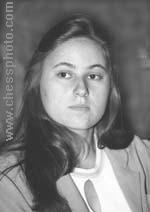Judit Polgár
- This article uses algebraic notation to describe chess moves.
- The native form of this personal name is Polgár Judit. This article uses the Western name order.
| Judit Polgár | |
 Photo by Gennadiy Titkov |
|
| Full name | Judit Polgár |
|---|---|
| Country | |
| Born |
July 23, 1976
Budapest, Hungary |
| Title | Grandmaster |
| FIDE rating | 2711 (No. 27 on the October 2008 FIDE ratings list) |
| Peak rating | 2735 (July 2005) at age 29 |
Judit Polgár (born July 23, 1976) is a Hungarian chess grandmaster. She is by far the strongest female chessplayer in history.[1] In 1991, she achieved the title of Grandmaster (GM) at the age of 15 years and 4 months. She was, at that time, the youngest person to do so. Polgár is ranked number 27 in the world on the October 2008 FIDE rating list with an Elo rating of 2711, the only woman on FIDE's Top 100 Players list, and has been ranked as high as number eight.
Contents |
Background
Judit Polgár is Jewish, and from Budapest. Members of her family perished in the Holocaust.
She and her two older sisters, Grandmaster Susan and International Master Zsófia, were part of an educational experiment carried out by their father László Polgár, in an attempt to prove that children could make exceptional achievements if trained in a specialist subject from a very early age. "Geniuses are made, not born," was László's thesis. He and his wife Klara educated their three daughters at home, with chess as the specialist subject. However, chess was not taught to the exclusion of everything else, as was the case with Gata Kamsky. Their father also taught his three daughters the international language Esperanto.
The rest of Judit's family eventually emigrated (Zsófia and her parents to Israel and later to Canada, Susan to New York), but she remained in Hungary and married Gusztáv Font, a veterinary surgeon from Budapest, whom she met through his caring for her dog.[2]
Career

Polgár has always preferred men's events, making it clear from the beginning that she wanted to become the true World Champion of Chess.
Trained in her early years by her sister Susan (who ultimately became Women's World Champion herself) Polgár was a prodigy from an early age. She first defeated an International Master (Dolfi Drimer) at age 10,[3] and a Grandmaster (Vladimir Kovacevic) at age 11.[4]
In 1994 she suffered a controversial defeat at the hands of then-world champion Garry Kasparov, the highest-rated chessplayer of all time. Kasparov changed his mind after making a losing move and then made another move instead. According to chess rules, once a player has released a piece s/he cannot make a different move, so Kasparov should have been made to play his original move. However, Polgár did not challenge this because she says there were no witnesses and an arbiter was not around. She was also unaware at the time that the re-move was caught on tape by a television crew. The tournament director was criticised for not forfeiting Kasparov when the videotape evidence was made available to him.[5] However, she won a rapid chess game against Kasparov in 2002.
On the November 1995 FIDE ratings list, Polgár's 2676 rating made her the number 10 ranked player in the world,[6] the first woman ever to enter the world's Top Ten.
In 2003, Polgár scored one of her best results: an undefeated clear second place in the Category 19 Corus chess tournament in Wijk aan Zee, Netherlands, just a half-point behind Indian star Viswanathan Anand, and a full point ahead of world champion Vladimir Kramnik.[7]
In 2004, Polgár took some time off from chess to give birth to her son, Olivér. She was consequently considered inactive and not listed on the January 2005 FIDE rating list. Her sister Susan reactivated her playing status during this period, and temporarily became ranked the world's number one woman player again.[8]
Polgár returned to chess at the prestigious Corus chess tournament on January 15, 2005, scoring 7/13. She was therefore relisted in the April 2005 FIDE rating list, gaining a few rating points for her better-than-par performance at Corus. In May she also had a better-than-par performance at a strong tournament in Sofia, Bulgaria, finishing third. This brought her to her highest ever rating, 2735, in the July 2005 FIDE list and enabled her to retain her spot as the eighth ranked player in the world.
In September 2005, Polgár became the first woman to play for a World Championship, at the FIDE World Chess Championship 2005. However, she had a rare disappointing performance, coming last out of the eight competitors. Nigel Short criticised her poor opening repertoire, and some speculated that taking a year off to have a baby may have left her rusty, despite her strong performances in two tournaments earlier in the year.
She did not play at the 2006 Linares tournament because she was pregnant again. On July 6, 2006, she gave birth to a girl, Hanna.
In October 2006, Polgár scored another excellent result: tied for first place in the Essent Chess Tournament, Hoogeveen, Holland.[9] She scored 4.5 out of 6 in a double round robin tournament that included two wins against the world's top-rated player, Veselin Topalov.
In May-June 2007 she played in the Candidates Tournament for the FIDE World Chess Championship 2007. She was eliminated in the first round, losing 3.5-2.5 to Evgeny Bareev.
In January 2008 she competed in the Corus Wijk aan Zee tournament, scoring a respectable 6.0/13.
In November 2008, Polgár played the number 2 board for the Hungarian open ("men's") team in the 38th Chess Olympiad in Dresden, finishing 3.5/8.
Illustrative games
- Polgar-GM Ferenc Berkes, Budapest 2003
1.e4 e6 2.d4 d5 3.Nc3 Nf6 4.Bg5 dxe4 5.Nxe4 Be7 6.Bxf6 Bxf6 7.Nf3 O-O 8.Qd2 Nd7 9.O-O-O Be7 10.Bd3 b6 11.Neg5 h6 12.Bh7+ Kh8 13.Be4 hxg5 14.g4 Rb8 15.h4 g6 16.hxg5+ Kg7 17.Qf4 Bb7 18.Rh7+ Kxh7 19.Qh2+ Kg8 20.Rh1 Bxg5+ 21.Nxg5 Qxg5+ 22.f4 Qxf4+ 23.Qxf4 Bxe4 24.Qxe4 1-0
- Polgar-Kasparov, Russia vs. The Rest of the World match, Moscow 2002
1.e4 e5 2.Nf3 Nc6 3. Bb5 Nf6 4.O-O Nxe4 5.d4 Nd6 6.Bxc6 dxc6 7.dxe5 Nf5 8.Qxd8+ Kxd8 9.Nc3 h6 10.Rd1+ Ke8 11.h3 Be7 12.Ne2 Nh4 13.Nxh4 Bxh4 14.Be3 Bf5 15.Nd4 Bh7 16.g4 Be7 17.Kg2 h5 18.Nf5 Bf8 19.Kf3 Bg6 20.Rd2 hxg4+ 21.hxg4 Rh3+ 22.Kg2 Rh7 23.Kg3 f6 24.Bf4 Bxf5 25.gxf5 fxe5 26.Re1 Bd6 27.Bxe5 Kd7 28. c4 c5 29.Bxd6 cxd6 30.Re6 Rah8 31.Rexd6+ Kc8 32.R2d5 Rh3+ 33.Kg2 Rh2+ 34.Kf3 R2h3+ 35.Ke4 b6 36.Rc6+ Kb8 37.Rd7 Rh2 38.Ke3 Rf8 39.Rcc7 Rxf5 40.Rb7+ Kc8 41.Rdc7+ Kd8 42.Rxg7 Kc8 1-0
Literature
- (1992) Cathy Forbes: The Polgar Sisters: Training or Genius?. Henry Holt & Co. ISBN 0805024263.
- (2002) Hurst, Sarah: Curse of Kirsan: Adventures in the Chess Underworld. Russell Enterprises. ISBN 1888690151.
- (2004) Károlyi, Tibor: Judit Polgar, the Princess of Chess. Batsford. ISBN 0-7134-8890-5
- (2005) Susan Polgar, Paul Truong: Breaking Through : How the Polgar Sisters Changed the Game of Chess. Everyman Chess. ISBN 1857443810.
- (2005) Jennifer Shahade, Chess Bitch: Women In The Ultimate Intellectual Sport. Siles Press. ISBN 189008509X.
References
- ↑ "Judit Polgar: 'I can work myself into the top ten again'". ChessBase (2007-11-11). Retrieved on 2008-02-04.
- ↑ "Queen Takes All, The Daily Telegraph".
- ↑ "Judit Polgar vs Dolfi Drimer".
- ↑ "Judit Polgar vs Vladimir Kovacevic".
- ↑ "The Kasparov touch-move controversy".
- ↑ Anatoly Karpov: Accident of Chess History? November 1995
- ↑ "FIDE profile of Judit Polgár".
- ↑ Why Judit Polgar was not on the ratings list January 14, 2005
- ↑ "Essent 2006: Mamedyarov, Judit Polgar are the winners".
External links
- FIDE rating card for Judit Polgár
- Judit Polgár at ChessGames.com
- Judit Polgar "Fan Club" - A blog devoted to J. Polgár news
- review of Judit Polgar The Princess of Chess